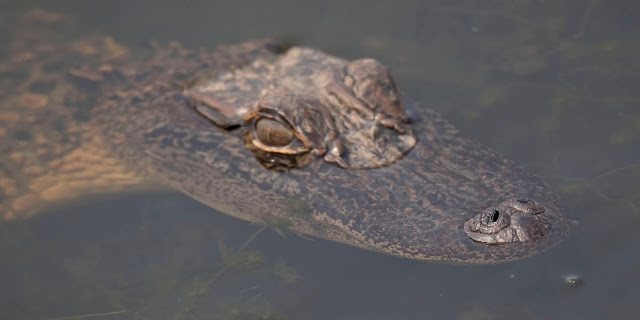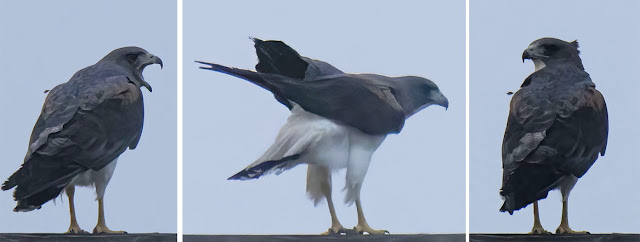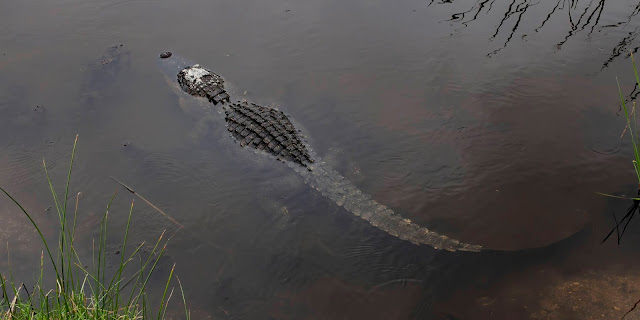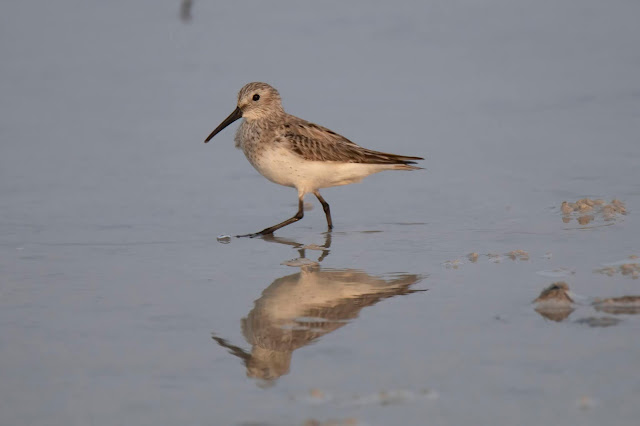 |
| Crested Caracara at Padre Island National Seashore |
Mississippi Sandhill Cranes
The rain caught up with us, so we slogged our way west, stopping only briefly at the Mississippi Sandhill Crane National Wildlife Refuge.
According to the signs, the refuge was established in 1975 under authority of the Endangered Species Act to “protect critically endangered Mississippi Sandhill Cranes and their unique, and itself endangered, wet pine savanna habitat.” I didn’t even know that there was a separate Mississippi subspecies (it doesn’t count as a new bird, but ….).
 |
| I have seen lots of Sandhill Cranes before; these were in New Mexico |
The Crane population there is currently at approximately 110, making them exceptionally rare. When we pulled in, we saw zero. Just a foggy, damp savannah.
 |
| Not good weather for birding |
As we were leaving, we saw an employee in a truck who told us that they were all deep in the pine woods, but there was a family of Cranes that lived about a mile away in a neighborhood.
 |
| Looking for Cranes in a soggy neighborhood |
So, like creepy stalkers, we drove up and down a lovely street lined with gracious southern homes on huge lots until we found them. They were walking over a hill in the fog.
 |
| Sandhill Crane family |
A few quick shots and then back on the Interstate heading for Texas.
Because it is the major "fly-way" for migrating birds, Texas is world-renowned as a spring birding site. I have had great experiences there before, so I was expecting a lot.
Unfortunately, the weather was not helpful – but wasn’t quite bad enough for a fallout (although I think there was one the NEXT week).
Anahuac National Wildlife Refuge
 |
| A protected bird |
We didn’t hit ALL the bird sanctuaries and National Wildlife Refuges, but we did make it to several.
The first stop was a new site for me and – in terms of variety and quantity – the best. In terms of new birds, not so much.
Anahuac National Wildlife Refuge is west of the town of High Island, Texas, and borders East Bay, part of the Galveston Bay complex, behind Bolivar Peninsula at the Gulf of Mexico.
 |
| The NWR protects birds and animals |
Established in 1963, the Refuge protects approximately 34,000 acres of coastal marsh and prairies and has a very nice wildlife drive with some boardwalks and observation decks.
 |
| The boardwalks give great access to birds |
Despite being hot and steamy, it was a pleasant stop. With no new birds, we probably stayed too long, which caught up with us later. But we did see Alligators …
 |
| I don't usually think of Gators living in Texas, but they do |
Pied-billed Grebes …
 |
| A very alert -- and cute -- Grebe |
White-faced Ibises …
 |
| These are beautiful birds in the sunlight |
Black-necked Stilts …
 |
| Graceful both flying and standing |
Common Gallinules …
 |
| Anahuac touted Purple Gallinules, but we only saw the Common species |
Red-winged Blackbirds …
 |
| A female Red-winged Blackbird |
Double-crested Cormorants …
 |
| The Double-crested Cormorant is known for its turquoise eyes |
Eastern Kingbirds …
 |
| Bird on a wire |
Red-eared Sliders …
 |
| Can't have marshes without Turtles |
Blue-winged Teals …
 |
| Dabbling ducks doin' what they do: dabbling |
And, a very cool Sesbania Tiger Beetle that flew into my car and wouldn’t leave …
 |
| When you really look, you can find cool bugs |
But, it was time to go, so we headed out toward our next stop, passing by some cattle grazing on the NWR.
 |
| Many National Wildlife Refuges allow farming or grazing on their property |
Galveston
We decided to forego the Interstate and instead drive through Galveston and take the ferry.
As we drove, we saw some of Texas’s iconic wildflowers (more about that in a future post) …
 |
| Indian Blanket |
And, a cute little Semipalmated Plover running down the beach …
 |
| Semipalmated Plover on the shore |
… as I photographed the Galveston Light ...
 |
| Galveston Light |
... and the cruise across the very short channel ...
 |
| Crossing the Channel |
... amid throngs of Laughing Gulls ...
 |
| Laughing Gulls |
Quintana Neotropical Bird Sanctuary
The extra time we spent at Anahuac combined with some bad weather bit us on our next destination. I had been to the funky little Quintana Neotropical Bird Sanctuary back in 2018 and saw some terrific birds (several lifers included).
 |
| I saw my first Hooded warbler at Quintana in 2018 |
So, naturally, I wanted to go back. But, we dawdled and dawdled and it was overcast and getting dark by the time we arrived.
As we neared the Sanctuary, we saw a Crested Caracara (Scott’s first) …
 |
| Crested Caracara |
… and some Black-bellied Whistling Ducks doing their very un-Duck-like trick of balancing on power lines ...
 |
| Balancing Duck |
But, the Sanctuary was silent – the only birds I saw were Grackles (although, you have to admit that these are extraordinary photos) …
 |
| female Great-tailed Grackle |
And, I also saw a Cotton Rat …
 |
| Cotton Rat |
I find that interesting because, with all my animal photos, I have captured only three rats or mice: one in Germany and the other two at Quintana.
 |
| Field Mouse, Cotton Rat and Yellow-necked Mouse |
Well, it was dead at sunset. No problem, we would just go back in the morning.
Nope.
 |
| Not the best weather for photography |
The floodgates opened that night and the morning brought darkness and gully-washing rain. There was nothing to do but press on.
Formosa Wetlands
 |
| Photo: Scott Stevens |
We stopped at Formosa Wetlands in Port Lavaca (which, apparently is not the same as the further inland Formosa-Tejano Wetlands) just because we were curious (and looking for a bathroom).
 |
| Formosa Wetlands is a nice town park |
It’s a small urban park with a boardwalk across coastal marsh out to the Gulf.
 |
| Texas certainly has lots of nice birding boardwalks |
The short visit was delightful, with quite a few birds and some lovely vistas.
 |
| A reflective Tri-colored Heron |
There was a beautiful Clapper Rail …
 |
| Rails are normally secretive, so this was a thrill |
Lots of Long-billed Dowitchers …
 |
| Dowitchers can be spotted by their up-and-down feeding pattern |
An elegant Greater Yellowlegs …
 |
| Walking through the reeds right below the boardwalk |
A Great Blue Heron …
 |
| I have seen Great Blue Herons in so many environments, but this seems like home |
Some White Ibises …
 |
| I never get tired of those bright blue eyes |
And, some Tri-colored Herons putting on quite a show …
 |
| A great spot for Tri-colored Herons |
A close one was hunting …
 |
| Looking for tiny morsels of food |
 |
| It was fun watching this Heron hunting at close range |
And, a distant one was dancing …
 |
| A graceful bird |
You never know what you are going to find. This (sort of) made up for the disappointment of Quintana (although no lifers).
Westward
And, on we drove through a very rural, agricultural part of Southeast Texas, passing flocks of Red-winged Blackbirds …
Hovering Swainson’s Hawks …
 |
| I didn't realize how common Swainson's were in Texas |
And, some Scissor-tailed Flycatchers …
 |
| This one is a female; its tail is shorter than a male's! |
What a beautiful bird!
Aransas National Wildlife Refuge
Our next stop was Aransas NWR, where I had had so-so luck with birds back in 2018, but had seen lots of Herons, a Whooping Crane, a Gray Fox and some Javelinas (and a dead Alligator that I photographer because I didn’t realize it was dead).
 |
| Part of Aransas National Wildlife Refuge's many marshes |
 |
| Black Vulture |
But, it was extraordinarily quiet -- plus a bit overcast and steamy. After the long drive, it was a disappointing.
We didn’t see much; just some distant Herons in the fog, a fair amount of Black Vultures ...
A Yellow-rumped Warbler …
 |
| Female Yellow-rumped Warbler |
Anhingas ...
 |
| A female Anhinga |
Some Cormorants …
 |
| Double-crested Cormorant |
And, at least, this time the Gator was alive!
Goose Island State Park
 |
| A Squirrel stretching in the heat |
Because if I found them in an open field, I never actually went in nearby Goose Island State Park.
This time, we did – and it paid off.
The Park has two distinct environments – Gulf beach and wooded campground. Both yielded some good birds.
On the beachy side, I saw a spectacular Reddish Heron is breeding plumage. No, this photo is not amped up. This bird was actually bright pink and baby blue ...
 |
| It took me a while to figure out what kind of Heron this was |
I had no idea.
 |
| So pretty! |
There were also a couple of shorebirds ...
 |
| Least Sandpiper |
But, the real fun was in the campground where a “resident” couple maintained bird feeders and baths.
 |
| On a hot day, the water attracts birds, including this Indigo Bunting |
I got a lifer!!!
 |
| A new Hummingbird for me |
A Buff-bellied Hummingbird ...
 |
| I love it when State Parks have blinds and feeding areas, which is common in Texas |
Plus, there was a Nashville Warbler …
 |
| Nashville Warbler |
A Hooded Warbler …
 |
| Texas has lots of colorful birds |
Indigo Buntings …
 |
| They didn't seem to want to share the space |
Gray Catbirds …
 |
| Catbird cooling off in the birdbath |
Red-winged Blackbirds …
 |
| Female Red-winged Blackbird |
Painted Buntings …
 |
| A male Painted Bunting, another gorgeous bird |
Ruby-throated Hummingbirds ...
 |
| Sharing space with a Honeybee |
And Northern Cardinals ...
 |
| A male and female Northern Cardinal |
Then, near Rockport’s fabled ”Big Tree” …
 |
| One of south Texas' legendary Live Oaks |
I got some nice photos of a Texas Spiny Lizard ...
 |
| This Lizard has personality |
It was a pretty good afternoon at Goose Island, where the sun came out and pumped the temperature up to over 90 degrees.
Padre Island National Seashore
 |
| A Reddish Egret and a Laughing Gull enjoying sunset |
Our final coastline destination was Padre Island, where I had also gone in 2018. Scott had not been there since he was in high school.
This time, because of the pandemic, many facilities were closed and it was relatively empty.
 |
| The pandemic was still keeping the crowds down |
The beach was pretty rough, which was also keeping the crowds away.
 |
| It's a nice beach, especially when the sun is out (which it wasn't) |
I had originally booked one night there, but Scott suggested we stay two because “why just stay one night at the beach?” Turns out, he was really saying that because he thought I would like two days of birding.
 |
| A blind by a pond |
But, I had already birded there -- and a lot of other places on the Gulf of Mexico -- so we didn't really need two nights.
Now, that is not to say it's not a great birding spot. It is and we saw quite a lot.
The Park, itself, has multiple environments and some nice boardwalks, viewing platforms and blinds.
I was looking forward to beach time because my last trip had been so glorious weather-wise. This time, it was windy, cool and phenomenally humid.
So, not much on the hanging out at the beach thing.
 |
| Two Willets on the wing |
 |
| Scott, enjoying the kitsch of the beach community |
While at Padre Island National Seashore, we did have some nice sightings, including Portuguese Man o’ Wars (Men o' War?) …
 |
| These things can be nasty; we didn't touch! |
White-tailed Deer ...
Lots and lots of birds ...
 |
| Birds congregating in a brackish pool |
Tri-colored Herons ...
 |
| A common beach bird |
Ruddy Turnstones …
Western Sandpipers ...
 |
| This was a new one for me! |
Willets …
 |
| The Eastern subspecies |
Brown Pelicans …
 |
| It wouldn't be the Gulf without Pelicans |
Laughing Gulls …
 |
| Their name derives from their call |
Black-bellied Plovers …
 |
| A Black-bellied Plover running down the Beach |
Lesser Yellowlegs …
Pectoral Sandpipers …
Royal Terns …
Long-billed Curlews …
 |
| That bill is impressive |
… including one catching and eating tiny crabs …
 |
| Check out his tiny prey |
… while being pursued by a Willet, which apparently wanted its treat ...
 |
| Fighting for dinner |
Mottled Ducks ...
 |
| A fairly common duck in Texas |
Black-bellied Whistling Ducks …
 |
| I saw these from a blind |
A White-tailed hawk ...
 |
| An impressive bird |
A Merlin …
 |
| A regal bird that is slightly goofy |
And, coolest of all, we saw several magnificent Crested Caracaras throughout the Park, including a pair we saw several times sitting and hunting in the same area.
We assumed they were a mated pair and that was confirmed on our final morning, when we witnessed them in the act. We captured the entire interaction.
 |
| Warning: graphic content |
About Crested Caracaras
The Crested Caracara is one of the coolest birds you can see in the U.S., albeit only in south Texas, New Mexico, Arizona and Florida.
 |
| Taking off |
They do occasionally venture outside of their range; one was photographed in Greely, Colorado, a few years ago.
 |
| They live in open areas |
The Crested Caracara looks like a hawk with its sharp beak and talons, behaves like a vulture and is technically a large tropical black-and-white falcon.
 |
| Crested Caracara |
The second largest falcon in the world, it has a wingspan of over four feet. The Crested Caracara lives in open country, often flying low with its wings held flat (distinguishing them from vultures) or walking on the ground.
 |
| The typical flight position |
A common subject of folklore and legends throughout Central and South America, the Crested Caracara is sometimes called the "Mexican Eagle," especially in Texas, where they have a different name for almost every bird "Buzzard" and "Chickenhawk", I'm looking at you).
 |
| A "Mexican Eagle" |
The Crested Caracara feeds mainly on carcasses of dead animals, but will steal food from other raptors, raid bird nests and take live prey if the possibility arises (mostly insects or other small prey, but at least up to the size of a snowy egret). It may also eat fruit.
 |
| The pair perching on low posts |
They often take live prey that has been flushed by wildfire, cattle and farming equipment and, therefore, seek out situations associated with their food such as wildfires and circling vultures.
 |
| Crested Caracara on a post |
Typically seen alone or in a pair, Crested Caracaras will gather in larger groups at a food source, such as a carcass or a dump.
 |
| They don't seem to be intimidated by people |
Breeding takes place in the spring or summer in the southern part of its range in Central and South America. But its breeding timing is less strict in warmer regions.
The oldest recorded Crested Caracara was at least 21 years, 9 months old when it was identified by its band in 2015 in Florida.
 |
| Crested Caracara |
We saw quite a few on this trip. And, that is always a treat.
Texas Coastal Birding
So, while the weather certainly had a dampening effect, we did manage to have a nice time. And, my appreciation for south Texas birding grew even more.
 |
| Formosa Wetland Boardwalk; Photo: Scott Stevens |
Trip date: April 1-19, 2021






















No comments:
Post a Comment